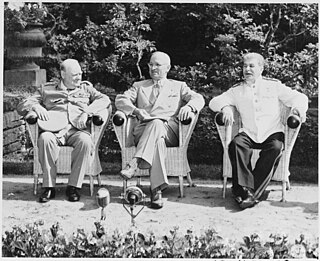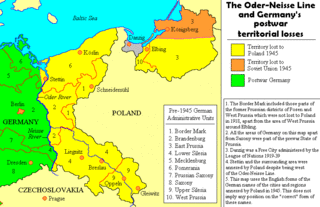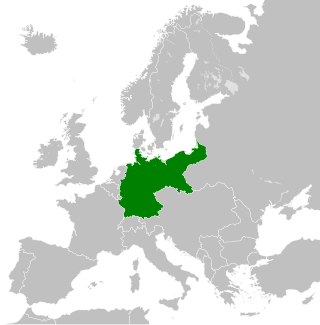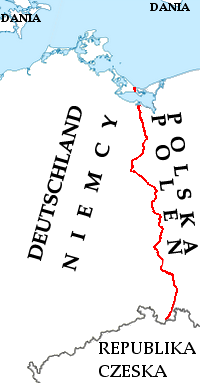
The Potsdam Conference was held at Potsdam in the Soviet occupation zone from July 17 to August 2, 1945, to allow the three leading Allies to plan the postwar peace, while avoiding the mistakes of the Paris Peace Conference of 1919. The participants were the Soviet Union, the United Kingdom, and the United States. They were represented respectively by General Secretary Joseph Stalin, Prime Ministers Winston Churchill and Clement Attlee, and President Harry S. Truman. They gathered to decide how to administer Germany, which had agreed to an unconditional surrender nine weeks earlier. The goals of the conference also included establishing the postwar order, solving issues on the peace treaty, and countering the effects of the war.

The Yalta Conference, held 4–11 February 1945, was the World War II meeting of the heads of government of the United States, the United Kingdom and the Soviet Union to discuss the postwar reorganization of Germany and Europe. The three states were represented by President Franklin D. Roosevelt, Prime Minister Winston Churchill, and General Secretary Joseph Stalin. The conference was held near Yalta in Crimea, Soviet Union, within the Livadia, Yusupov, and Vorontsov palaces.

The former eastern territories of Germany refer in present-day Germany to those territories east of the current eastern border of Germany, i.e., the Oder–Neisse line, which historically had been considered German and which were annexed by Poland and the Soviet Union after World War II in Europe. In most of these territories, Germans used to be the dominant or sole ethnicity. In contrast to the lands awarded to the restored Polish state by the Treaty of Versailles after World War I, the German territories lost with the Potsdam Agreement after World War II in Europe on 2 August 1945 were either almost exclusively inhabited by Germans before 1945, mixed German-Polish with a German majority, or mixed German-Czech with a German majority (Glatz). Virtually the entire German population of the territories that did not flee voluntarily in the face of the Red Army advance of 1945, was expelled to Germany, with their possessions being expropriated.

At the end of World War II, Poland underwent major changes to the location of its international border. In 1945, after the defeat of Nazi Germany, the Oder–Neisse line became its western border, resulting in gaining the Recovered Territories from Germany. The Curzon Line became its eastern border, resulting in the loss of the Eastern Borderlands to the Soviet Union.

The Soviet occupation zone in Germany was an area of Germany that was occupied by the Soviet Union as a communist area, established as a result of the Potsdam Agreement on 1 August 1945. On 7 October 1949 the German Democratic Republic (GDR), commonly referred to in English as East Germany, was established in the Soviet occupation zone.

The Treaty of Zgorzelec between the Republic of Poland and East Germany (GDR) was signed on 6 July 1950 in Zgorzelec, Poland.
The Treaty of Warsaw was a treaty between the Federal Republic of Germany and the People's Republic of Poland. It was signed by Chancellor Willy Brandt and Prime Minister Józef Cyrankiewicz at the Presidential Palace on 7 December 1970, and it was ratified by the West German Bundestag on 17 May 1972.

The entirety of Germany was occupied and administered by the Allies of World War II from the Berlin Declaration on 5 June 1945 to the establishment of West Germany on 23 May 1949. Unlike occupied Japan, Germany was stripped of its sovereignty and former state: after Nazi Germany surrendered on 8 May 1945, four countries representing the Allies asserted joint authority and sovereignty through the Allied Control Council (ACC) under the Berlin Declaration of 5 June 1945 that led to the fall of the German Reich. At first, Allied-occupied Germany was defined as all territories of Germany before the 1938 Nazi annexation of Austria; the Potsdam Agreement on 2 August 1945 defined the new eastern German border by giving Poland and the Soviet Union all regions of Germany east of the Oder–Neisse line and divided the remaining "Germany as a whole" into four occupation zones, each administered by one of the Allies.
The formation of the European Advisory Commission (EAC) was agreed on at the Moscow Conference on 30 October 1943 between the foreign ministers of the United Kingdom, Anthony Eden, the United States, Cordell Hull, and the Soviet Union, Vyacheslav Molotov, and confirmed at the Tehran Conference in November. In anticipation of the defeat of Nazi Germany and its allies this commission was to study the postwar political problems in Europe and make recommendation to the three governments, including the surrender of the European enemy states and the machinery of its fulfillment. After the EAC completed its task it was dissolved at the Potsdam Conference in August 1945.

"Restatement of Policy on Germany", or the "Speech of Hope", is a speech given by James F. Byrnes, the US Secretary of State, in Stuttgart on September 6, 1946.
The presence of German-speaking populations in Central and Eastern Europe is rooted in centuries of history, with the settling in northeastern Europe of Germanic peoples predating even the founding of the Roman Empire. The presence of independent German states in the region, and later the German Empire as well as other multi-ethnic countries with German-speaking minorities, such as Hungary, Poland, Imperial Russia, etc., demonstrates the extent and duration of German-speaking settlements.

The territorial evolution of Germany in this article include all changes in the modern territory of Germany from its unification making it a country on 1 January 1871 to the present although the history of "Germany" as a territorial polity concept and the history of the ethnic Germans are much longer and much more complex. Modern Germany was formed when the Kingdom of Prussia unified most of the German states, with the exception of multi-ethnic Austria, into the German Empire. After the First World War, on 10 January 1920, Germany lost about 13% of its territory to its neighbours, and the Weimar Republic was formed two days before this war was over. This republic included territories to the east of today's German borders.

The flight and expulsion of Germans from Poland was the largest of a series of flights and expulsions of Germans in Europe during and after World War II. The German population fled or was expelled from all regions which are currently within the territorial boundaries of Poland: including the former eastern territories of Germany annexed by Poland after the war and parts of pre-war Poland; despite acquiring territories from Germany, the Poles themselves were also expelled from the former eastern territories of Poland annexed by the Soviet Union. West German government figures of those evacuated, migrated, or expelled by 1950 totaled 8,030,000. Research by the West German government put the figure of Germans emigrating from Poland from 1951 to 1982 at 894,000; they are also considered expellees under German Federal Expellee Law.

As a result of World War II, Poland's borders were shifted west. Within Poland's new boundaries there remained a substantial number of ethnic Germans, who were expelled from Poland until 1951. The remaining former German citizens were primarily autochthons, who were allowed to stay in post-war Poland after declaring Polish nationality in a verification process. According to article 116 of the German constitution, all former German citizens may be "re-granted German citizenship on application" and are "considered as not having been deprived of their German citizenship if they have established their domicile in Germany after May 8, 1945 and have not expressed a contrary intention." This regulation allowed the autochthons, and ethnic Germans permitted to stay in Poland, to reclaim German citizenship and settle in West Germany. In addition to those groups, a substantial number of Poles who never had German citizenship were emigrating to West Germany during the period of the People's Republic of Poland for political and economic reasons.

The Berlin Declaration of 5 June 1945 or the Declaration regarding the defeat of Germany, had the governments of the United States, the Soviet Union, the United Kingdom, and France, acting on behalf of the Allies of World War II, jointly assume de jure "supreme authority" over Germany after its military defeat and asserted the legitimacy of their joint determination of issues regarding its administration and boundaries prior to the forthcoming Potsdam Conference.
The German–Polish Border Treaty of 1990 finally settled the issue of the Polish–German border, which in terms of international law had been pending since 1945. It was signed by the foreign ministers of Poland and Germany, Krzysztof Skubiszewski and Hans-Dietrich Genscher, on 14 November 1990 in Warsaw, ratified by the Polish Sejm on 26 November 1991 and the German Bundestag on 16 December 1991, and entered into force with the exchange of the instruments of ratification on 16 January 1992.

The bilateral relations between Poland and Germany have been marked by an extensive and complicated history.

The Oder–Neisse line is an unofficial term for the modern border between Germany and Poland. The line generally follows the Oder and Lusatian Neisse rivers, meeting the Baltic Sea in the north. A small portion of Polish territory does fall west of the line, including the cities of Szczecin and Świnoujście.
After World War II both West Germany and East Germany were obliged to pay war reparations to the Allied governments, according to the Potsdam Conference. Other Axis nations were obliged to pay war reparations according to the Paris Peace Treaties, 1947. Austria was not included in any of these treaties.

The Germany–Poland border is the state border between Poland and Germany, mostly along the Oder–Neisse line, with a total length of 467 km (290 mi). It stretches from the Baltic Sea in the north to the Czech Republic in the south.















